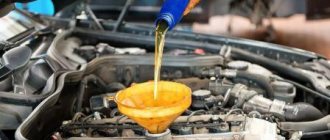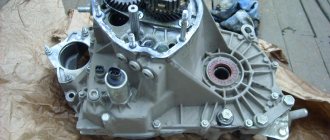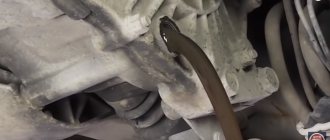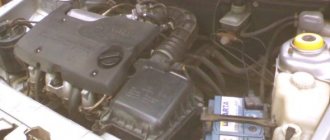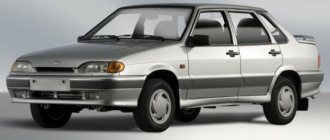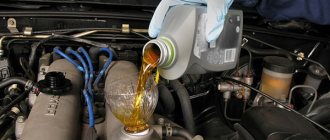Flushing the engine before changing the oil, including scheduled flushing, is not a harmless procedure; it will negatively affect the condition of the internal combustion engine. When drained, up to 10% of the old oil volume remains. If flushing was used, some of it will remain inside the engine crankcase after oil change operations.
This will negatively affect the life of the motor. When it is heavily contaminated, intensive removal of deposits can clog small-diameter lubrication channels, as a result of which the internal combustion engine system may soon fail.
Is it always necessary to flush the engine before changing the oil?
Engine deposits occur for the following reasons:
- use of counterfeit oil or oil with inappropriate characteristics;
- violation of the oil change interval, oil change according to modern regulations (15-30 thousand km);
- engine wear, which causes a large amount of exhaust gases to enter the crankcase.
If you plan to change the oil again, you should evaluate the degree of contamination of the power unit. To do this, you need to remove the filler cap and find out the degree of cleanliness of the parts. If there is no obvious contamination in the form of thick deposits, then there is no need to flush the engine.
If there are a lot of deposits, then it’s worth thinking about - maybe you don’t need to flush the engine, but remove the valve cover and the lower part of the engine crankcase, and manually remove all the dirt that your hand can reach.
This is not a major overhaul, the cost is 2 gaskets and a day of work. This way, most of the deposits will be removed and will not clog small-diameter technological lubrication channels. Accordingly, the risk of early engine failure is minimized.
Let's summarize.
As you can see, the old saying is confirmed again: “Too much of a good thing is also not good!” If you perform flushing, as they say, “should and don’t,” you can achieve the opposite effect and cause harm to the “heart” of your car. If you care about the health of your car’s engine, it will be enough to simply monitor its condition during, or better yet, change the engine oil ahead of schedule, and also do not pour low-quality engine oil into the engine. If the issue of flushing does arise, then I advise you to trust the professionals; they will certainly know how to properly flush the engine of your car.
A classic of the Soviet automobile industry, the VAZ 2106, has earned the love of car enthusiasts as a cheap car to maintain. Most often, owners try to carry out repairs and maintenance themselves. Changing the engine oil is one of these maintenance operations that you can do yourself if you carefully follow the instructions.
How to flush the engine
There are two types of flushes:
- special cleaning oils,
- additives to old oil.
Flushing compounds wash out deposits well, but do not have sufficient lubricating properties. The engine wears out intensively when running on such oil. Additives for old oil can react chemically with it, which can also cause negative consequences.
If you decide to use this type of rinsing, you should read the instructions for the product used. Let us dwell on washing options that have a long history.
Flushing the engine with diesel fuel before changing the oil
Diesel oil softens deposits, but is not able to dissolve them. After washing with diesel fuel, there is a high probability of clogging the oil receiver mesh filter. As a result, the engine will experience oil starvation and accelerated wear of friction pairs. Diesel oil is good for cleaning the parts of a disassembled engine, but you should not use it during the next oil change.
Flushing with gasoline
Gasoline has a negative effect on oil seals and is a flammable liquid. You should not flush the engine with it before replacing it.
However, during the operation of worn-out gasoline engines in winter, when driving mainly short distances on a cold engine, a lot of fuel gets into the oil, and it does not have time to evaporate. Therefore, you can artificially create such a situation when changing the oil.
To do this, on a cold engine, remove the oil level dipstick and fill in about 5-10% of the oil fill volume. This is the only way to fill gasoline, and not through the standard oil filler neck.
Then insert the dipstick into place, start the engine and let it run for 10 minutes. Then turn off the engine and drain the oil. This method is only suitable for gasoline power units.
This is an inexpensive way to flush gasoline engines, and it certainly does no more harm than using various flushing additives—five minutes. The oil will become thinner and the gasoline will wash away any deposits. This method cannot be used for diesel engines.
TOP 3 best liquids for flushing the cooling system
LAVR Radiator Flush
LAVR Radiator Flush Classic . LAVR is a Russian brand of auto chemical goods. LAVR Radiator Flush Classic is an excellent solution for flushing the cooling system of any car. Product catalog number is LN1103. The approximate cost of a 0.43 liter package is $3.5, and a 0.98 liter package is $5.10.
A 430 ml bottle will be enough for you to use in a cooling system with a total volume of 8.10 liters. The composition is poured into the system and topped up with warm water to the MIN mark. After this, the engine should run for about 30 minutes at idle speed. Next, the product is removed from the system and washed with distilled water for 10.15 minutes with the engine running at idle. After this, you can fill in new antifreeze.
The useful properties of the product include an increase in the service life of antifreeze by 30.40%, effective removal of scale, antifreeze decomposition products, rust, and dirt. Contains a corrosion inhibitor, increases the life of the pump and thermostat.
| Positive feedback | Negative reviews |
| I simply used the Laurel wash because literally shortly before I had just used a ring decarbonizer under the same name, I saw the result, so I decided not to tempt fate and use a product from the same company. | No negative reviews found. |
| At one time I also used Laurel on a VAZ-21099. The impressions are only positive. But I also did washings every two years. So I never had dirt in the cooling system. | . |
7-Minute Hi-Gear Radiator Flush
Hi-Gear Radiator Flush - 7 minutes . Manufactured in the USA by Hi-Gear. Sold in the CIS countries, as well as Europe and America. Hi-Gear cooling system flushing is a very popular remedy among motorists all over the world. Article: HG9014. The price of one 325 ml can is about $4.6.
How to flush the engine when changing the oil
If a flushing additive is used, it is poured through the oil filler hole. The engine is started and allowed to run for the time recommended by the manufacturer of the flushing composition. Then the engine is turned off, the old oil is drained, the oil filter is replaced and new oil is added.
If flushing oil is used, then the old motor oil is drained and flushing oil is added. Then drive the car for the washing distance recommended by the manufacturer. Afterwards the oil is drained, the oil filter is changed and new oil is added.
How to flush the lubrication system on all VAZ cars?
1) Flushing is actually quite simple, you can find more details on how to flush the lubrication system with one or another flushing fluid on the jar itself in which the flushing fluid is located, usually all jars have instructions for their use and they are all used in different ways, some kind of flushing fluids need to be used by starting the engine of the car and letting it run for 15 minutes so that the remaining oil leaves the system, some kind of flushing fluids need to be mixed with the engine oil itself and then drive 100-200 km and thereby The engine will also be cleaned, so as you already understand, you need to look at the instructions on the jar of liquid as everything is described in detail on it.
2) But so that you don’t forget, always remember a few rules, namely, before purchasing a fluid, make sure that it is suitable for your oil, that is, the flushing fluid is for mineral oils, as well as for synthetic oils, etc., therefore, when choosing a flush, take this into account; in addition, also pay attention to which car engine the flush is used for and you do not need to take a flush for diesel cars if in fact you have a gasoline one.
Note! In addition, if you want to make the flushing better, then you can buy a new oil filter at the auto store and install it only for the time of flushing; it doesn’t make sense to buy something too expensive since you will only need to install it and then throw it away, so take a relatively cheap one a filter that would simply act as a plug (so that oil does not leak out of the engine), and it is recommended to install a new one during flushing only because your old filter is dirty and mixing the flushing fluid with dirt will only weaken the flushing effect and thus it will not as good as it should be!
When to rinse
The best way to flush is to change the oil more frequently. The oil should be changed at least once a year. Despite manufacturers' recommendations, it is optimal to change the oil and oil filter after 7.5 thousand km.
At the same time, you should not constantly change the brand of oil - it is better to choose one and constantly use it. In this case, the remnants of the old oil will not negatively affect the composition of the new one. The oil will not have time to wear out and form solid deposits in the engine structure.
When designing the power unit, the manufacturer calculated the optimal characteristics of the lubricating oil. Washing work is not provided. Therefore, they should not be used without good reason. Only a “doctor” (a qualified mechanic mechanic) can prescribe “treatment” for an engine by flushing.
Leaks and problems
The higher the mileage of the VAZ 2106, the more problems appear, as in principle with any car. Most often this is due to natural wear and tear of the engine, causing oil to burn. Although the manufacturer allows for a small consumption.
There can be many reasons why an engine eats oil. And in each case they can be individual. But, over the years of the model’s existence, we can talk about the most common places where leaks occur.
If the breather is spewing or throwing oil, or if there is oil in the exhaust manifold, this may indicate a serious problem with the oil rings. In this case, you can try decoking with dimexide. But it is better to use special auto chemicals designed for these purposes.
A leak from under the valve cover may be due to a worn gasket. Sometimes simply replacing the gasket does not solve the problem. Since the cover itself may have significant curvature. Therefore, in some cases it will have to be replaced.
A white emulsion in the engine or on the oil filler cap may indicate condensation. This is a common occurrence when temperatures change from minus to plus, mainly in autumn or spring.
But if the emulsion is also observed on the dipstick, then this is already a sign of more serious problems. Most often we can talk about a broken cylinder block gasket. And in rare cases, a cracked cylinder head may be to blame.
Also, with this problem, you can find oil in the expansion tank. Sometimes, simply replacing the gasket is not enough. It may be necessary to grind the head itself, and this is completely different money for repairs.
All this is general information, which may manifest itself differently on each specific vehicle, since everyone’s operating modes are different. The same applies to places of leaks or oil leaks. Therefore, it is impossible to identify the cause from a distance.

